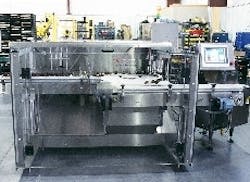Good things come in small packages, but not usually the packaging machines themselves. Bottling and capping machines, for example, are usually as big as small cars or office cubicles. Instead of listening to tradition or rationalizations, however, developers at ESS Technologies Inc. in Blacksburg, Va., decided to listen to their customers.
Our customers saw there was a scarcity of high-tech, middle-speed, servo-driven, balcony-designed bottle filler/cappers that could handle glass and plastic containers from 2-3 milliliters up to 16 ounces, says Walter Langosch, ESS sales and marketing director. Historically a case packer manufacturer, ESS also realized that building a filling machine would move it further onto its users production lines. "Servos were especially needed because they ensure accuracy, and provide flexibility for quick changeovers. Were talking about 20-min product changeovers, and a 10-12 min average when just changing sizes, which makes MB120 perfect for short-run pharmaceutical manufacturers doing 3,000 to 10,000-unit runs and 10 changeovers per shift.
MB120s control system was developed according to ESS specifications by Integrated Motion Inc., one of B&Rs U.S-based partners. These controls included control architecture, machine sequence of operation, PLC I/O and the operator interface. What makes this machine unique is its highly integrated control system, including its drives networking and CAN interface, says Jim Mullins, Integrateds engineering vice president. Users also benefit from MB120s reduced wiring and costs. Also, B&Rs X67 system simplifies wiring the sensors and solenoids.
With a footprint of only 6 x 5 ft, MB120 also saves precious floor space. Though designed and built to metric standards, MB120 also meets U.S. Food and Drug Administration (FDA) regulations. Besides the dual-pitch MB120, which fills and caps 120 containers per minute, ESS also offers a single-pitch MB60 that runs at 60 containers per minute. The dual-pitch machine caps two bottles at a time, while the single-pitch device caps one bottle.
Besides its integrated control architecture, MB120 includes a stainless-steel balcony to aid cleaning and maintenance. ESS adds that many competing technologies havent yet combined the filling and capping process into one clean-balcony-designed machine, which makes this system attractive to increasingly regulated pharmaceutical and cosmetics manufacturers.
The clean balcony design along with B&Rs Acopos servo drives makes this a perfect fit for these applications, says Kevin Brown, ESS president. MB120s other unique features include quick size change, good visibility for the operator, and feedback controls from a check-weigher for automatic fill volume adjustment. The servo filling system also can do profile filling for irregularly shaped containers.
During its packaging process, bottles are fed into MB120 via an in-feed conveyor. This servo-driven conveyor runs continuously through the machine. After the bottles enter the system, theyre fed into a servo-driven timing screw, which controls the position of the bottles for the filling process. Once these bottles are on pitch in the timing screw, the servo-driven fill head moves vertically down into the bottles. The filling pumps, which also are servo driven, allow users to meter the fill for accurate profile filling. This process prevents potential splashing and foaming that can be caused by fluids of different consistencies and bottles with different shapes and sizes.
In addition, MB120s HMI allows the operator to adjust the positions of the pump, the nozzle and the speeds on its screen, which reportedly ensures a completely flexible filling process. Next, when the timing screw indexes the next group of bottles into the process, the filled bottles leave the filling area via the continuous in-feed conveyor. The bottles are then fed into a capping starwheel. A centrifugal sorter feeds the caps, orients them, releases the clamps and pre-torques the cap onto the bottle. The next station tightens the cap with constant, accurate torque using magnetic clutches, which is a mechanically controlled process. Once the cap is screwed onto the bottle, the finished bottles are discharged from the dial and leave the machine via an exit conveyor.
MB120 is making our clients packaging lines more efficient, which helps them be the low-cost per-unit producer in their respective markets, and makes them more profitable as well, adds Langosch.





